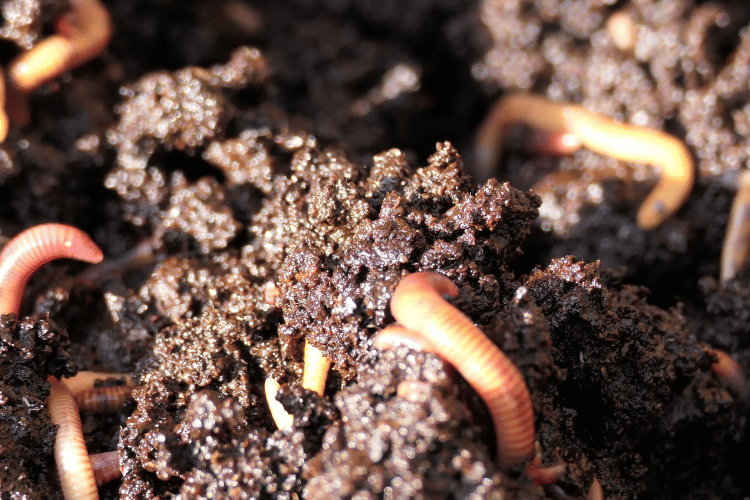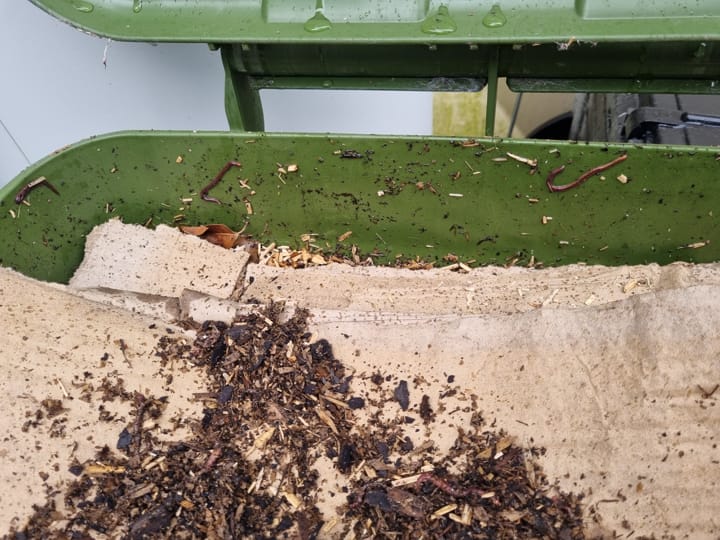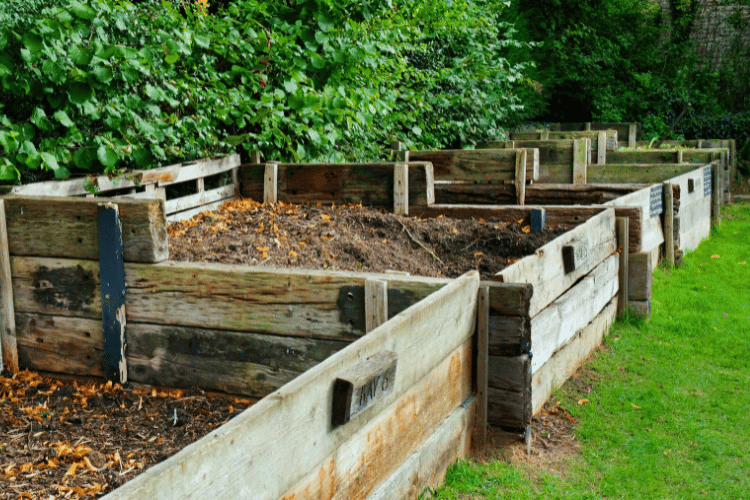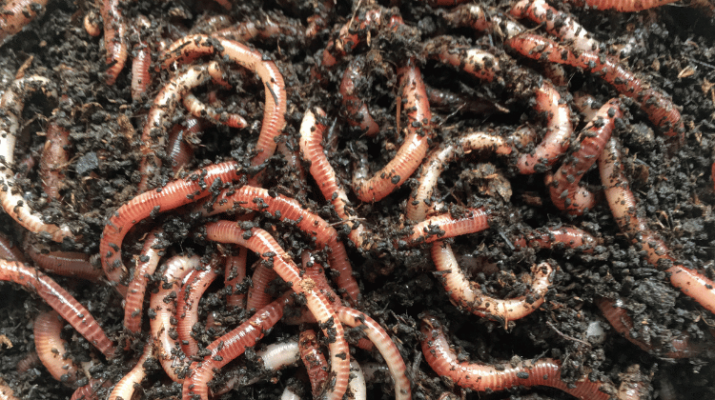Worms have the fantastic ability to turn organic waste into compost for plants. A common problem that various composters face is finding their worms at the top of the bin. This makes you wonder why they’re crawling to the top instead of staying in.
Usually, this means that the environment in the bin is unsuitable for them, so they’re trying to escape. Don’t worry; we’ll tell you how to send them back inside.
If you’ve been asking “Why are my worms at the top of the bin,” we have the answer. In this guide, we’ll tell you how to create a suitable environment for your worms, so they stay inside their compost bin.
The Main Reasons Worms Are Escaping the Bin
Before we explore the reasons worms are leaving the bin, we need to know their preferred living environment. Here’s a list of the conditions worms like in compost bins:
- Moist but not excessively wet
- Good air circulation
- Proper bedding (to absorb moisture and allow oxygen flow)
- Temperatures from 40℉ to 90℉
- Dark space
- pH level between 6.5 and 7
- Variety of organic material
So, if worms lack any of those conditions in the bin, they’ll want to escape. Let’s explore why those unsuitable conditions may occur and how to solve them.
Excess Moisture
Some food or organic material in the worm bin may have high moisture levels. This will cause the worms’ bedding to become too wet, and the worms will drown in the water.
Excess moisture can also cause mold to grow, creating an unpleasant odor in your bin.
The way to solve this problem is by keeping the worms’ bedding dry. The best worm bedding is shredded newspaper or brown cardboard, coconut coir, straw, and hay.

These are all carbon-rich materials that can absorb and hold moisture. They also make good food for the worms.
Another way to prevent excess moisture is to avoid adding overly wet foods to the bin. These include melons, tomatoes, and berries. Also, avoid adding dairy products as they can attract pests.
Those pests can be dangerous as they might prey on the worms or eat their food.
Not Enough Oxygen
There may be a lack of ventilation in the bin, causing the worms to crawl up because they need oxygen. Your bin should have enough air holes to allow proper ventilation. You also need to check that the holes aren’t blocked, as this happens sometimes.
Another tip is to avoid throwing food on top of the worms. Wait for the worms to dig tunnels and holes in the bin, which they use for oxygen. Then, as the food decreases, slowly add more. Overfeeding, or throwing food excessively on top of the worms can also lead to poor ventilation.
Wrong Temperature
Worms prefer temperatures ranging from 40℉ to 90℉ and can sense if it gets too high or too low. If the temperature drops or rises too much, the bin will become too cold or hot for them.
Therefore, they’ll try to escape to find a more suitable place. To regulate the bin’s temperature, keep it in a shaded area, away from direct sunlight.
Ensure the bedding is moist (not soggy) to keep the worms moist. When the weather is too cold, you can place a heat lamp above the bin to keep it warm.
When the weather is too hot, you can wrap a frozen water bottle in some newspaper and place it in the bin to keep the soil cool.
Wrong pH Level
Worms prefer their environment to be slightly acidic. If the bin gets too acidic or alkaline, it becomes irritating to the worms’ skin. The bin will normally be more on the acidic side because of the chemical process involved in the breakdown of organic matter.
To maintain the bin’s pH level, avoid adding acidic foods such as oranges, lemons, and pineapples.
You could also add crushed eggshells to the bin twice a month. Eggshells are alkaline so they help balance the acidity level.
Too Much Light
Worms are photophobic creatures, which means they don’t tolerate light. That’s why they naturally live underground where it’s dark.
Exposure to light may happen because of a small crack in the bin. The worms will then try to escape to find a darker spot. To prevent this, make sure you keep your bin in a dark space, and that there aren’t any cracks that allow light inside it.
Overly Crowded Bin
Worms reproduce in large numbers. Hundreds or even thousands of newly hatched worms might be added to the bin. The adult worms will feel that it’s too crowded for them and will try to escape.
To solve this problem, pick up the worms at the top of the bin and start a new bin with them. You can also give them away to a friend who wants to start their compost bin or use them as bait for fishing.

Condensation
Worms are usually attracted to condensation as it’s a source of moisture for them. The air above the compost bin is normally warm as the worms generate heat.
When the warm air contacts the bin’s cold surface, it will create condensation and form water droplets. Some worms will start crawling toward those water droplets seeking their moisture.
This is natural, and you shouldn’t worry about it. You minimize the amount of condensation by regulating the temperature inside the bin.
Vibration
Worms are sensitive to vibrations and loud noises, and they cause them to become stressed. Many composters keep their bins in the laundry or utility rooms.
These rooms include machines that vibrate, such as washing machines and dryers. The machines also run for several minutes or longer than an hour at a time. This can trigger the worms, causing them to escape in search of a quieter location.
To avoid this, keep your compost bin in a quiet room, away from any vibration sources.
A Change in the Environment
Worms adapt to their living space. So, if you introduce changes to their bedding, and food, or change the bin’s location to a different temperature. If the worms are unhappy with the recent changes, they’ll try to escape to look for a more comfortable home.
Try to figure out what you might be doing differently and get it back to normal. For instance, if you’ve started adding citrus foods, this could irritate the worms and you should go back to their previous diet.
Wrong Feeding Portions
Your worms might escape because you’re overfeeding or underfeeding them. Worms require a balanced diet to stay healthy.
If you overfeed the worms, you could increase the acidity of the soil, suffocate them with excess food, or create a toxic environment as the food rots. All these are reasons that will cause the worms to escape.
However, if you underfeed the worms, they’ll also try to escape to look for food somewhere else.
The best approach is to frequently feed your worms small amounts of food rather than large amounts over long periods.

Tips for a Healthy Bin Environment
So now you know the common reasons that lead worms to escape from the bin. Let’s discuss some care tips so you can provide the best environment for your worms that makes them want to stay in their bin.
Adjust Bedding Consistency
Suitable bedding for worms has to be moist but not too wet. To check the bedding’s consistency, hold some of it in your hand and squeeze it tightly. If water comes out, then it’s too wet.
To solve this problem, you can add some dry bedding and mix it in to reach the right consistency. However, if the bedding is wet beyond repair, then you’ll need to make a new one.

Monitor Food Consumption
To adjust your worms’ feeding amount, monitor their food consumption over a small period. Notice if your worms might be over or under-eating by checking the amounts of food left in the bin.
Reduce the amount of food if you see a lot left uneaten, and add more food if no or little food is left.
Feed Your Worms a Balanced Diet
To remain healthy, worms need a balanced ratio of brown and green foods (around 70:30). Brown foods include paper, dried plants, wood, sawdust, and cardboard.
Green foods include vegetable scraps, wet plants, fruit peels, and young plants.
The brown foods provide the worms with carbohydrates, while the greens provide them with nitrogen and protein. Avoid feeding your worms any dairy products or oily food.
Spray Water When It Gets Too Dry
If you live in a hot or dry area, the compost will dry often. Since the worms like moisture, the environment will become unsuitable for them.
A good tip is to keep a spray bottle of water next to the bin. When the weather becomes too hot, spray the top layer of the bedding every few days to keep it moist.
Keep Bad Odors Out
Your bin should normally smell like earth or soil, so if it’s emitting any foul odors, it means that there’s a problem causing it. Overfeeding your worms may lead to food rotting in the bin and creating that unpleasant smell.
Another reason could be giving your worms the wrong food. Food that’s too oily or contains dairy will rot quickly causing a bad smell in the bin.
It’s also possible that dead worms are causing the bad smell. Even one dead worm can produce a bad odor in the entire bin.
Make regular checkups on your bin and see if you find any dead worms on the surface then remove them immediately.
FAQs
Here are some questions commonly that people who keep compost bins commonly ask.
How many worms should I add to the compost bin?
The number of worms should depend on the amount of food waste your household produces and the size of the compost bin. For a regular-sized bin, start with 1lb of worms (900-1000 worms).
If you have over four adults in your household, the food waste might require around 2lb of worms. It’s better to start with an average number and gradually add more worms to your bin.
How do I harvest the worm castings?
Using a small trowel, scoop some castings out from the bin. If the material is broken down well, you’ll have clear castings. However, you might need to sift through it to remove worms and food pieces.
Another method of harvesting is screening which involves using a screen to separate the food pieces and worms from the casting. You can easily make the screen using a wooden frame and hardware cloth.
How often should I feed the worms?
Worms can eat half of their weight daily. So, 1lb of worms will eat 1/2lb of food per day. You should feed your worms every two to three days, by putting enough food for the number of days in the bin.
Monitor your worms’ food consumption to check if you need to increase or decrease their food amounts.
How often do worms reproduce?
Worms become ready to breed when they reach the age of 50-90 days. The mating process usually takes 24 hours. Worms hatch from their capsules in 7-21 days.
Each capsule holds from two to 20 worms, but the average number is six. You can expect new baby worms in your compost bin every month.
Conclusion
Worms have the amazing ability to turn organic waste into compost for plants. However, worms need a proper environment to stay healthy and live inside a compost bin.
When worms start crawling to the top of the bin, it means that something inside is irritating or stressing them out. This could be the wrong temperature or moisture level, lack of oxygen, or exposure to sunlight.
To combat those problems and keep your worms healthy, you need to feed your worms the right food, maintain the proper moisture level, and adjust the bin’s pH levels.
By following the care tips in this guide, you can provide a comfortable home for your worms and keep them healthy so you can enjoy their benefits.

